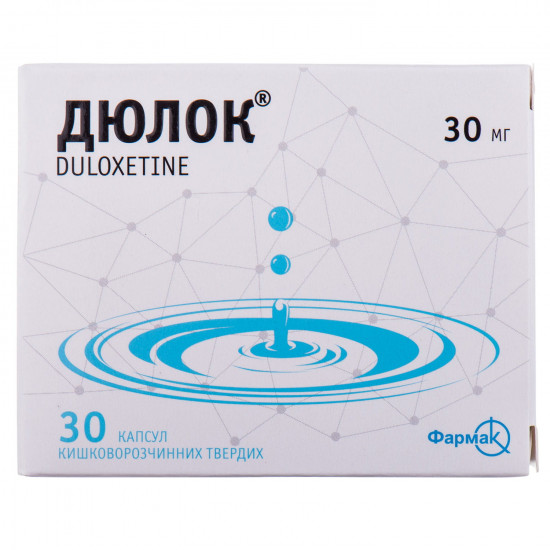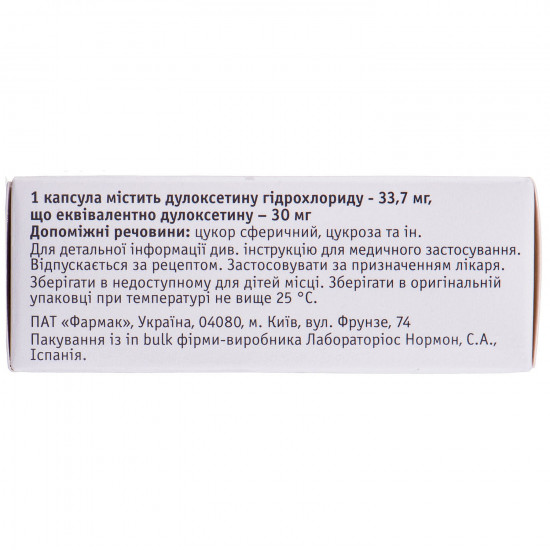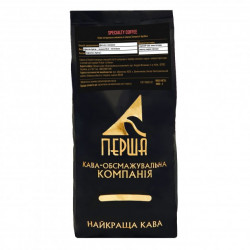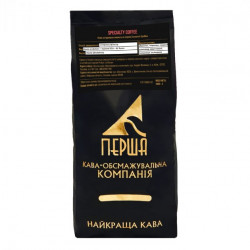



- Stock: In Stock
- Model: 184321
0% Customers recommend this product
-
5 Awesome0%
-
4 Great0%
-
3 Average0%
-
2 Bad0%
-
1 Poor0%
Reviews Over Dyulok kaps. firm kishechnorast. 30 mg No. 30
- (0)
Total Reviews (0)
click here write review to add review for this product.
Report this review.
Description
Dyulok capsules are shown at:
- Treatment of big depressive disorder.
- Treatment of diabetic peripheral neuropatichesky pain.
- Treatment of a generalized anxiety disorder.
Structure
Active ingredient: duloxetine;
1 capsule supports a duloksetin of a hydrochloride – 33.7 mg or 67.4 mg that is equivalent to a duloksetin – 30 mg or 60 mg;
Excipients: spherical sugar, hydroksipropilmetiltsellyuloza, polyethyleneglycol 6000, talc, sucrose, acetate hydroksipropilmetiltsellyuloza succinate, triethyl citrate;
No. 3 firm gelatin capsule (for capsules of 30 mg): Structure of a cover of the capsule: titan dioxide (E 171), indigotin blue (E 132), gelatin;
No. 1 firm gelatin capsule (for capsules of 60 mg): structure of a cover of the capsule: titan dioxide (E 171), indigotin blue (E 132), quinolinic yellow (E 104), erythrosine (E 127), gelatin.
Contraindication
- Contraindication for use of medicament is the hypersensitivity to a duloksetin or to any excipient of drug. Duloksetin cannot appoint
- together with non-selective irreversible monoamine oxidase inhibitors (MAO) or at least for 14 days after the treatment termination by MAO inhibitors. Considering a half-life period of a duloksetin, it is impossible to appoint MAO inhibitors at least for 5 days after the treatment termination duloksetiny. Dyulok cannot appoint
- patient with unstable hypertensia as it can provoke hypertensive crisis. Dyulok cannot appoint
- patient with an end-stage of a renal failure (clearance of creatinine to 30 ml/min.). Dyulok patients should not appoint
- with liver diseases – it can cause a liver failure. Duloksetin is not recommended to appoint
- to children in connection with insufficiency of data on its safety and efficiency of use of this age category of patients. Dyulok should not appoint
- in a combination with fluvoksaminy, ciprofloxacin or enoksatsiny (strong CYP1A2 inhibitors) because of increase in concentration of a duloksetin in blood plasma.
Route of administration
In big depressive disorder. Duloksetin is appointed in a dose of 60 mg of 1 times a day, irrespective of meal.
to Some patients can appoint bya daily dose higher than 60 mg – to the maximum dose of 120 mg a day, distributed on 2 receptions. The possibility of purpose of doses more than 120 mg systematically was not estimated.
In diabetic peripheral neuropatichesky pain. The recommended initial dose makes 60 mg of 1 times a day, irrespective of meal. Some patients can appoint a daily dose higher than 60 mg – to the maximum dose of 120 mg a day distributed on 2 receptions.
Therapeutic effect of treatment is shown byfor 2 months.
In a generalized anxiety disorder. The recommended initial dose makes 30 mg of 1 times a day, irrespective of meal. In case of insufficient effect of treatment it is necessary to increase a dose to 60 mg a day. On condition of insufficient effect of treatment in a dose of 60 mg it is possible to consider increase in a dose to 90 or 120 mg a day.
Therapeutic effect of treatment is shown byfor 2–4 weeks.
PregnantUse of medicament during pregnancy is recommended to
Feature of use
byonly under a condition if the expected advantage for the pregnant woman exceeds potential risk for a fruit. Children
Clinical trials concerning use of a duloksetin to children were not conducted by
therefore medicament is not used in pediatric practice. Drivers
during treatment to patients should abstain from potentially dangerous types of activity requiring special attention and speed of psychomotor reactions.
OverdoseData on overdose of a duloksetin are limited to
. There are messages about reception of high doses (up to 1400 mg) a duloksetina separately or in a combination with other medicines that had no lethal outcomes. Overdose symptoms (mainly at a combination with other medicines) included drowsiness, a coma, a serotoninovy syndrome, epileptic seizures, vomiting and tachycardia.
Treatment. Specific antidotes are unknown. At emergence of a serotoninovy syndrome the specific treatment (use of cyproheptadine and/or control of temperature) is necessary. The passability of airways needs to be checked. It is recommended to carry out monitoring of warm activity and control of key indicators of activity together with the appropriate symptomatic and supporting measures. Gastric lavage can be appropriate if it is carried out right after administration of drug. Activated carbon reduces medicament absorption. Duloksetin has the large volume of distribution in an organism in this connection an artificial diuresis, hemoperfusion and exchange perfusion will be hardly useful.
toSide effects
byIt was reported about dizziness, nausea and a headache as adverse symptoms at the termination of reception of a duloksetin. At the termination of reception of a duloksetin it was also reported about disturbance of sensitivity, a sleep disorder, excitement or uneasiness, a tremor, irritability, diarrhea and a hyperhidrosis.
- from an endocrine system: hypothyroidism.
- from the immune system: anaphylactic reactions, hypersensitivity.
- from metabolism: loss of appetite, hyperglycemia, dehydration, hyponatremia, syndrome of inadequate secretion of antidiuretic hormone.
- from mentality: insomnia, agitation, decrease in a libido, uneasiness, abnormal visions and abnormal orgasm, sleep disorders, bruxism, disorientation, apathy, suicide thinking, mania, hallucinations, aggression and malignancy, suicide behavior.
- from nervous system: headache, drowsiness, dizziness, tremor, paresthesias, myoclonia, akathisia, nervousness, attention disorders, lethargy, dyskinesia, disturbances of taste, restless legs syndrome, bad dream, serotoninovy syndrome, spasms, extrapyramidal disorders.
- From dock of organs of sight: indistinct image, mydriasis, disorders of vision, xerophthalmus, glaucoma.
- from organs of hearing: a ring in ears, vertigo, ear pain.
- from a cardiovascular system: heartbeat; tachycardia inflows; supraventricular arrhythmia; fibrillation, atrial is more often; arterial hypertension; increase in arterial blood pressure; orthostatic hypotension; loss of consciousness; cryesthesia in extremities; hypertensive crisis.
- from a respiratory system: yawning, oropharyngeal pain, feeling of compression in a throat, nasal bleeding.
- from a digestive tract: nausea, vomiting, dyspepsia, a meteorism, an abdominal pain, a constipation, diarrhea, gastrointestinal bleedings, a gastroenteritis, an eructation, gastritis, stomatitis, an unpleasant smell from a mouth, presence of blood in Calais, dryness in a mouth.
Interaction
Drugs operating on the central nervous system. At reception of a duloksetin in a combination with other medicaments operating on the central nervous system, especially with the similar mechanism of action, including alcohol and sedative medicines it is necessary to observe certain precautionary measures.
MAO Inhibitors. Duloksetin it is not necessary to appoint together with the MAO (MAO) non-selective irreversible inhibitors because of risk of emergence of a serotoninovy syndrome. At intake of reverse selection monoamine oxidase inhibitors (MAO), for example a moklobemida, the risk of emergence of a serotoninovy syndrome is less, however use of such combination is not recommended.
Medicines containing duloksetin. It is necessary to avoid combined use with other medicines containing duloksetin.
Drugs containing a St. John's wort grass. At combined use with the medicament Dyulok often there are side reactions.
Storage conditionsto Store
at a temperature not above 25 °C in original packing. to Store
out of children's reach.
Expiration date - 2 years.
Specifications
| Characteristics | |
| Active ingredients | Duloksetin |
| Amount of active ingredient | 30 mg |
| Applicant | Pharmak |
| Code of automatic telephone exchange | N06AX21 Duloksetin |
| Interaction with food | It doesn't matter |
| Light sensitivity | Not sensitive |
| Market status | The branded generic |
| Origin | Chemical |
| Prescription status | According to the prescription |
| Primary packing | blister |
| Producer | PUBLIC JOINT STOCK COMPANY PHARMAK |
| Quantity in packing | 30 capsules (3 blisters on 10 pieces) |
| Release form | capsules for internal use |
| Route of administration | Oral |
| Sign | Domestic |
| Storage temperature | from 5 °C to 25 °C |
| Trade name | Dyulok |




















